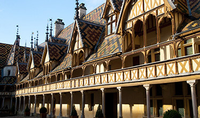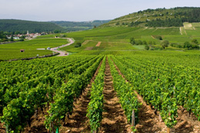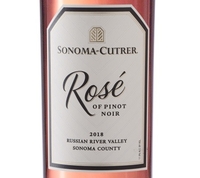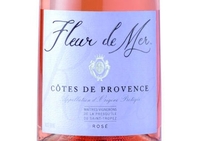|
|
 |
|
July 16, 2019
As the heat of summer sets in, my mind turns toward wines that speak most eloquently when sun comes fully ablaze each day in all its glory. I’m far from alone in having those thoughts turn to rosé. Thankfully, the current craze for dry versions seems to have no ceiling, and more and more producers are jumping on the bandwagon with each successive vintage.
My first memories of wine, undoubtedly like many Americans my age, involve rosé wines consumed by my parents in the late 1960’s. Brands like Lancers and Mateus, which were on the  sweet side, but came off as tart, fresh and delicious to a child raised on chocolate milk and sugar-infused cereals. Today, the best dry rosé wines grab me the same way that those simple wines did years ago. sweet side, but came off as tart, fresh and delicious to a child raised on chocolate milk and sugar-infused cereals. Today, the best dry rosé wines grab me the same way that those simple wines did years ago.
My attention was grabbed in a big way recently by the 2018 Halter Ranch Rosé. The winery is located on the west side of the Paso Robles area in the Adelaida District, the westernmost of eleven sub-appellations established in 2014. It’s in the transition zone of Winkler Region 2 and 3 in terms of growing “degree days,” and can receive more than twenty five inches of rainfall annually. Elevations go from 900 to 2200 feet above sea level, and the vineyards regularly have diurnal temperature swings of as much as forty degrees during the growing season.
All of this means that it’s a real sweet spot for wine grapes. Simply put, it’s on the cool side, but within its boundaries are several microclimates that allow a wide range of grape varieties to perform at a high level. In the case of Halter Ranch, this means a focus on both Rhône and Bordeaux varieties spread across 280 acres of the 900 owned.
Kevin Sass, a Cal State Fresno - educated winemaker who has been at Halter Ranch since 2011, blends Grenache, Mourvedre and Picpoul Blanc again in 2018, with percentages near the ’17 version of the wine, and it’s a stunner of a rosé. The wine was crafted with a clear intention to stand above its competors in terms of aroma, flavor, finish and food pairing versatility.
It’s a beautiful, crisp, dry wine that hits all my rosé markers -- strawberry, white pepper, racy acidity, mild leafy herbs and a long, lip smacking citrus driven finish that doesn’t wipe off the other flavor elements, thanks in part to a core of stony minerality that keeps the flavor elements bobbing and weaving on the palate. It’s the best Rosé I’ve tasted in a good long while -- including examples from Provence, Tavel and the like.
I suspect that the inclusion of the Picpoul Blanc makes this wine a standout. The acidic pop it delivers carries the fruit, spice and other elements long into the wine’s finish…and likewise keeps my glass in need of refilling. 95 Points
Posted by Rich Cook at 10:42 AM
|
|
July 10, 2019
Record-breaking temperatures hit France and elsewhere in Europe recently with Beaune, in the heart of Burgundy, recording temperatures of over 100 degrees. While those kinds of  temperatures are common in California wine country, they are rare in Burgundy and immediately raise the question: How the vines and grapes faring? temperatures are common in California wine country, they are rare in Burgundy and immediately raise the question: How the vines and grapes faring?
Burgundy has seen warm vintages recently; 2015 and 2009 spring to mind. Both of those years produced sensational reds and very good, but perhaps early-drinking whites. Still, the temperatures in those years were not close to what Burgundy experienced this June. The heat in June reminded people to whom I spoke about the canicule (dog days of summer, or heat wave) that occurred in August of 2003.
The persistently high temperatures during the day--and even more importantly at night--in 2003 altered the character of the wines. High nocturnal temperatures draw down malic acid levels in the grapes, resulting in lower-than-usual acidity, which, in turn, especially for the whites, translated into flabby wines. Compounding the problem in 2003 was that the heat came toward the end of the growing season, when it was dry, accelerating ripening. Sugar levels in the grapes jumped unexpectedly and caught vintners off guard while they were away on their traditional August  vacation. As a result, many grapes stayed on the vines too long and the many of the resulting wines tasted cooked or over-ripe. vacation. As a result, many grapes stayed on the vines too long and the many of the resulting wines tasted cooked or over-ripe.
Such outcomes were not uniformly the case, thankfully. Showing how hard it is to predict how wines will develop, two 2003 red Burgundies that I tasted in 2016, both from Jadot--their Beaune Clos des Ursules and the Gevrey-Chambertin Clos St Jacques--I drank in 2016 were superb, fresh and still youthful. There are exceptions to almost everything in the world of wine, but still…extreme heat certainly imperils the potential quality of fine wine.
The heat of 2019 is not that of 2003. At least not yet. Frédéric Barnier, Maison Louis Jadot’s very smart and talented winemaker, told me that he envisioned no damage so far, explaining that  canicule is not a problem if the vines have water and leaves, which they do now because of lots of rain during the spring. Indeed, he thought the extra heat helped, because the vines were behind schedule because of this year’s cool, rainy spring, and the heat allowed them to catch up. However, he notes that more heat later in the growing season could be a big problem because now the ground is “dry, very dry.” He felt bad for the growers who, unluckily, had performed rognage (leaf removal to expose the newly formed grapes to more sunshine and to help dry the bunches) just before the heatwave hit. canicule is not a problem if the vines have water and leaves, which they do now because of lots of rain during the spring. Indeed, he thought the extra heat helped, because the vines were behind schedule because of this year’s cool, rainy spring, and the heat allowed them to catch up. However, he notes that more heat later in the growing season could be a big problem because now the ground is “dry, very dry.” He felt bad for the growers who, unluckily, had performed rognage (leaf removal to expose the newly formed grapes to more sunshine and to help dry the bunches) just before the heatwave hit.
Megan McClune, the Managing Director at Domaine Jessiaume in Santenay, agreed that the dryness could be a problem because there has been little rain--and none is forecast for the next several weeks.
It’s impossible to assess a vintage until the grapes are in the winery and the wine has been made. Even then, as those two 2003s from Jadot showed, early assessments of the wines can be faulty. But at this point, Burgundy is on guard….
Posted by Michael Apstein at 12:48 PM
|
|
July 7, 2019
Ruffino, Chianti Classico Gran Selezione (Tuscany, Italy) “Riserva Ducale Oro” 2014 ($41): Gran Selezione is a new category of Chianti Classico that is supposed to represent the pinnacle of a producer’s bottling. Whether it does is a matter of debate because some producers’ top wine from Chianti Classico region is not a Gran Selezione. from Chianti Classico region is not a Gran Selezione.
What’s not a debate is that the Gran Selezione designation means it is superb wine. Indeed, Ruffino has been making Riserva Ducale Oro for decades, since 1947. It has always been a monumental achievement in Chianti Classico, a wine that ages and develops gracefully and beautifully over the decades. Calling it Gran Selezione, which they started with the 2010 vintage, does not, in my mind, change its already exalted stature.
2014 Riserva Ducale Oro shows why it’s important not to be a slave to vintage charts. The 2014 vintage in Tuscany was, to put it diplomatically, difficult. Read: Not so good. But talented and conscientious producers, such as Ruffino make excellent wine in bad (excuse me, “difficult”) vintages. They just make less of it--in this case, about 15 percent less than average--by performing a severe selection and selling off what’s not up to snuff.
Enough background. The wine, a blend chiefly of Sangiovese (85%), Merlot (10%) and Colorino, is delicious with the classic melding of fruit, earth and acidity for which great Chianti Classico is known. It’s a savory and ripe combination with lip-smacking Tuscan acidity, which is just what you want to keep it fresh during a meal.
The vintage speaks in the approachability of this wine. It’s a fine choice for drinking now, but having had many Riserva Ducale Oro, even from “difficult” vintages, I know that they evolve beautifully, so there’s probably no rush with this one either. I scored it at 93 Points, and recommend it enthusiastically.
Posted by Michael Apstein at 5:04 PM
|
|
July 3, 2019
Fireworks needn’t be the only sizzle in your Fourth of July celebration this week. You can bring a bit of sparkle to the party with a crisp, dry rosé wine long before the pyrotechnics begin.
Everyone will thank you because few adult beverages are as refreshing on a hot summer day. That’s only one of the reasons dry rosés are suddenly changing minds and winning fans. The other is a dramatically improved product.
As demand for dry rosé has grown throughout the U.S. in recent years, more top producers have hopped aboard the bandwagon, resulting in greater selection and better wines. I suggest four for the Fourth.
 Sonoma-Cutrer is a case in point. Long known for its exquisite Chardonnay and Pinot Noir, Sonoma-Cutrer has trained its guns on a dry rosé made from Russian River Valley Pinot Noir. The most recent vintage, 2018, earned a Platinum award and a score of 94 points at the Critics Challenge in June. Retail price: $23. Sonoma-Cutrer is a case in point. Long known for its exquisite Chardonnay and Pinot Noir, Sonoma-Cutrer has trained its guns on a dry rosé made from Russian River Valley Pinot Noir. The most recent vintage, 2018, earned a Platinum award and a score of 94 points at the Critics Challenge in June. Retail price: $23.
It was barely nudged out of Best of Show honors by the 2018 Fleur de Mer Rosé ($20) from the Cotes de Provence AOP in the south of France. Both are superb examples of the genre, with lively though subtle fruit aromas and crisp acidity.
 And back in April, two California wineries, Navarro and Etude, best known for aromatic whites and elegant Pinot Noir respectively, scored big at the San Diego International Wine Challenge with rosé of Pinot Noir. And back in April, two California wineries, Navarro and Etude, best known for aromatic whites and elegant Pinot Noir respectively, scored big at the San Diego International Wine Challenge with rosé of Pinot Noir.
The Etude ($22) captured Best of Show honors with a rosé from Santa Barbara County and the Navarro ($22) scored a gold medal with a beautiful rosé from Mendocino’s Anderson Valley.
What they all deliver is a zesty, refreshing warm-weather beverage option that is modestly priced and widely distributed throughout the U.S. This Fourth of July, bring your own fireworks, bring a great rosé.
Posted by Robert Whitley at 8:24 AM
|
|
 |
|